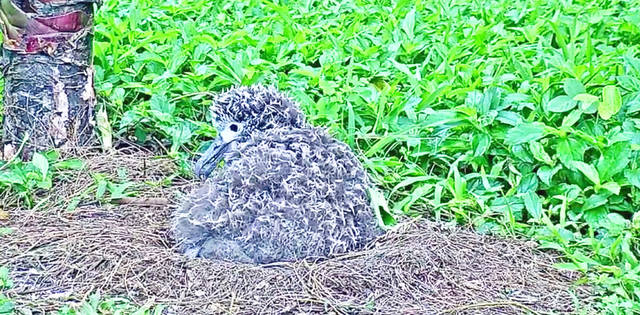KILAUEA — On Thursday afternoon, three Laysan albatross chicks were starring on Cornell Lab’s Kauai North Shore Tross Cam and moving sticks around their nests was the order of business for the day.
Makalii is the oldest of the trio and hatched Jan. 29, followed by Moikeha on nest number two. Kiamanu finished up the on-camera hatching on Feb. 3.
In between stick moving, the chicks will preen. Occasionally they’ll flap their little wings, or wobble out of their nests to explore. Intermittently their parents show up and feed them a slurry of half-digested squid and fish.
“Everything about them is fun to watch,” said Hob Osterlund of the Kauai Albatross Network. “The way they explore their surroundings, the way they get excited when their parents arrive with food, the way they see the world with such fearless curiosity.”
The first days of three chicks are broadcast worldwide through the livestream online camera, but they’re not the only ones growing up on the island.
There are 15 chicks at the camera site alone, and about 175 chicks that have hatched on island so far this season, which began in January.
In late December, the Kilauea Point National Wildlife Refuge reported 161 established nests, a 20 percent increase over the previous five-year average of 134 nets.
That’s encouraging for conservationists who have been monitoring the population, which is at about 2.5 million with the majority of breeding pairs on Midway Island — a total of about 400,000 pairs.
On Midway Atoll National Wildlife Refuge, 67-year-old Wisdom is raising her ninth chick currently.
The species isn’t on the endangered list, but it is on the 2016 North America’s Birds’ Watch List, which highlights species that are at risk of extinction if conservation actions aren’t taken.
Albatross face many threats, including marine debris, invasive species, shrinking habitat and longline commercial fishing, according to USFWS.
Those threats aren’t just in the wide expanse of their oceanic home, either. The chicks growing up in their nests often face challenges from predators.
“Some season the worst predators are domestic dogs or feral cats,” Osterlund said, “This year it’s pigs.”
Albatross chicks will remain in their nests on land for about the first 160 days of their lives, until they fledge.
When they do, they’ll be about 50 percent larger than the adults, according to scientists, and the extra weight helps them survive until they can figure out how to feed themselves.
Juvenile albatross return to the colony three years after fledging and often don’t start mating until they are 7 or 8 years old.
The three chicks on the live-streaming camera can be watched until they fledge in late June/early July.


